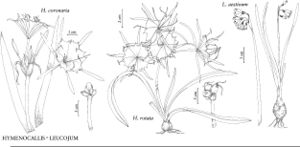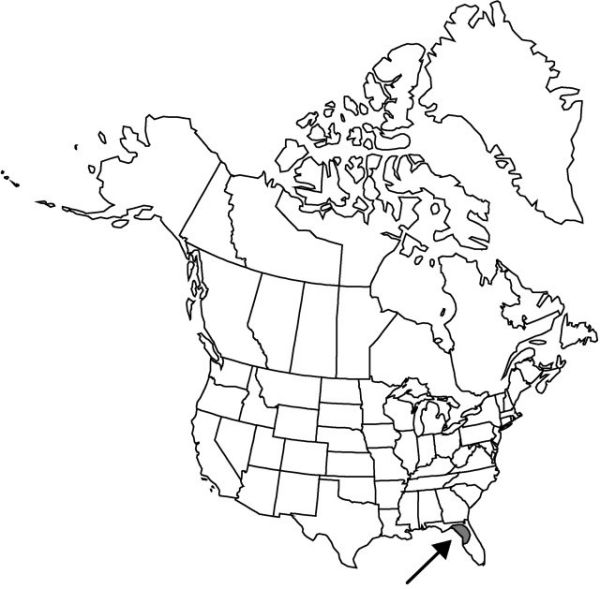Hymenocallis rotata
Appendix, 44. 1821.
Bulb rhizomatous, broadly ovoid, 6–8 × 3–6 cm; basal plate 3–6 cm; neck 3–5 cm; tunic grayish brown. Leaves deciduous, 3–9, arching upward to suberect, 4–10 dm × 2–5(–7) cm, coriaceous; blade deep green, liguliform, strongly channeled proximally, apex acute, glaucous at base. Scape 3.5–7 dm, 2-edged, glaucous; scape bracts 3, enclosing buds, 4–7.5 × 1.3–2 cm; subtending floral bracts 3.5–6 cm × 5–10 mm. Flowers 2–4, opening nearly at same time, fragrant; perianth tube green, (7.5–)9–12 cm; tepals extending nearly horizontally from base of corona, white, green-striped along keel and at base and apex, 9–14.5 cm × 7–15 mm; corona white with small, yellowish green proximal eye, rotate at full anthesis, distinctly tubulose proximally, 4–6 × 6–9 cm, margins between free portions of filaments with 2 or 3 prominent lacerate projections; free portions of filaments inserted on flat base, suberect, white except green proximally, 2.5–4 cm; anthers 1.5–2 cm, pollen yellow; ovary oblong to pyramidal, 2–3 cm × ca. 10 mm, ovules 4–6 per locule; style green in distal 1/2, becoming white proximally, 16–26 cm. Capsules elongate, 4–6 × 2–3 cm. Seeds elongate, 2–3 × 1.5–2 cm. 2n = 48.
Phenology: Flowering late spring–early summer.
Habitat: Margins of spring-run streams
Elevation: 0 m
Discussion
Of conservation concern.
Hymenocallis rotata is known chiefly from the spring runs south of Tallahassee, and is found also along other springs to the east and down the peninsula. Although it may be locally abundant, it is restricted to the immediate vicinity (including ditches and lakes) of the spring runs.
A. F. Clewell (1985) treated Hymenocallis rotata as the sole representative of the genus in the Florida panhandle, concurring with the decision made by R. K. Godfrey and J. W. Wooten (1979). Collections often have been misidentified as either H. crassifolia or H. coronaria, and the name H. floridana has been applied to some specimens.
Hymenocallis rotata is a striking species with its large, liguliform, deep green leaves, and flowers with large, rotate staminal coronas. In width, the corona is similar to that of H. coronaria, but it is not chalicelike in shape, and its free tepal tips are widely spreading rather than ascending. In cultivation as a garden ornamental since the seventeenth century, H. rotata seems to thrive in most semitropical areas, especially along the banks of streams or wet ditches.
Selected References
None.

